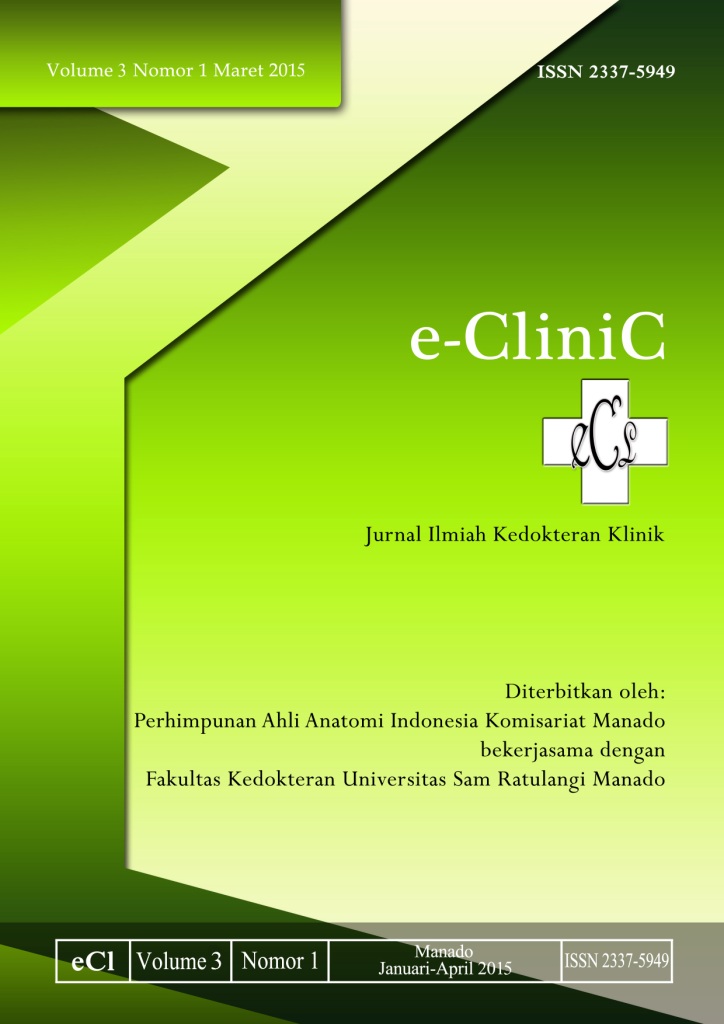HUBUNGAN STATUS GIZI DAN BERAT LAHIR PADA ANAK USIA 2-3 TAHUN
DOI:
https://doi.org/10.35790/ecl.v3i1.6751Abstract
Abstract: Based on Riskesdas 2013, national prevalence of severely underweight 5,7%, underweight 13,9%, normal 75,9% and overweight 4,5%. Many factors affect the nutritional status of children under 5 years: socio-economic, maternal education, place of residence, birth status, infection, genetic, immunization, the status of breastfeeding, complementary feeding, health care, intervals of pregnancy and birth weight. Small for gestational age (SGA) refers to infants born weighing less than the weight of pregnancy it is supposed to. Catch up growth leads low birth weight baby to reach or to exceed a normal weight later. Catch up growth spontaneously occurred in 2 years old children and without spontaneous catch up growth at 3 years, it is not possible to experience it later without therapeutic intervention. The purpose of this study is to measure the weight and height of children aged between 2-3 years old with a history of SGA, determine nutritional status and determine the relationship between nutritional status and birth weight. This research took place at Prof Dr RD Kandou Hospital Manado and samples’ house, from October to December 2014. This study was an observational analytic study with cross-sectional approach and used consecutive sampling method. There were 39 children aged between 2-3 years old with a history of SGA as samples, who were born in Prof Dr RD Kandou Hospital from December 2011 to December 2012. Nutritional status by weight for age 5,1% severely underweight, 15,4% underweight, 79,5% normal; by height for age 25,6% severely stunted, 28,2% stunted and 46,2% normal; by weight for height 5,1% wasted, 89,8% normal and 5,1% overweight; by BMI for age 5,1% stunted, 84,6% normal and 10,3% overweight. There is no relationship between nutritional status and birth weight in children aged between 2-3 years old with a history of SGA (p> 0.05).
Keywords: nutritional status, birth weight, SGA
Abstrak: Berdasarkan Riskesdas 2013, prevalensi nasional gizi buruk 5,7%, gizi kurang 13,9%, gizi baik 75,9% dan gizi lebih 4,5%. Banyak faktor yang yang mempengaruhi status gizi anak dibawah 5 tahun: sosial-ekonomi, pendidikan ibu, tempat tinggal, status kelahiran, infeksi, genetik, imunisasi, status menyusui, makanan pendamping, perawatan kesehatan, interval kehamilan dan berat lahir. Kecil masa kehamilan (KMK) mengacu pada bayi lahir dengan berat kurang dari berat seharusnya untuk masa kehamilan itu. Tumbuh kejar menyebabkan bayi dengan berat badan lahir rendah mencapai atau melebihi berat badan normal di kemudian hari. Tumbuh kejar spontan terjadi pada usia 2 tahun dan anak tanpa tumbuh kejar spontan pada usia 3 tahun tidak mungkin untuk mengalami hal itu kemudian tanpa intervensi terapeutik. Tujuan penelitian ini adalah untuk mengukur berat badan dan tinggi badan anak 2-3 tahun dengan riwayat KMK, menentukan status gizinya dan mengetahui hubungan antara status gizi terhadap berat lahir. Lokasi penelitian di RSUP Prof Dr RD Kandou Manado dan rumah sampel penelitian, dari Oktober-Desember 2014. Penelitian ini merupakan analitik observasional dengan pendekatan potong lintang dan menggunakan metode consecutive sampling. Didapatkan sampel sebanyak 39 anak usia 2-3 tahun dengan riwayat kecil masa kehamilan yang lahir di RSUP Prof Dr RD Kandou periode Desember 2011 – Desember 2012. Status gizi menurut BB/U gizi buruk 5,1%, gizi kurang 15,4%, gizi baik 79,5%; menurut TB/U sangat pendek 25,6%, pendek 28,2% dan normal 46,2%; menurut BB/TB kurus 5,1%, normal 89,8% dan berat badan lebih 5,1%; menurut IMT/U kurus 5,1%, normal 84,6% dan berat badan lebih 10,3%. Tidak ada hubungan antara status gizi dan berat lahir pada anak usia 2-3 tahun dengan riwayat KMK (p>0,05).
Kata kunci: status gizi, berat lahir, KMK
Downloads
Published
How to Cite
Issue
Section
License
COPYRIGHT
Authors who publish with this journal agree to the following terms:
Authors hold their copyright and grant this journal the privilege of first publication, with the work simultaneously licensed under a Creative Commons Attribution License that permits others to impart the work with an acknowledgment of the work's origin and initial publication by this journal.
Authors can enter into separate or additional contractual arrangements for the non-exclusive distribution of the journal's published version of the work (for example, post it to an institutional repository or publish it in a book), with an acknowledgment of its underlying publication in this journal.
Authors are permitted and encouraged to post their work online (for example, in institutional repositories or on their website) as it can lead to productive exchanges, as well as earlier and greater citation of the published work (See The Effect of Open Access).







